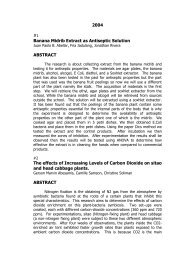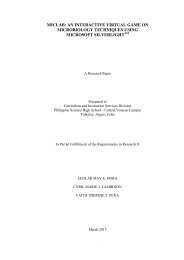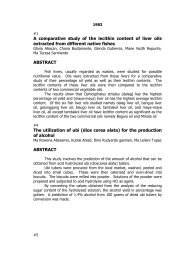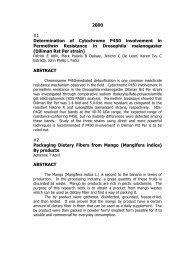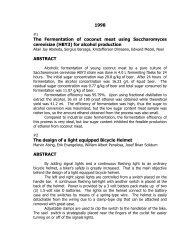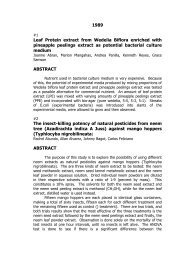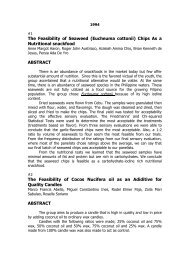2008 Analysis of the Geometry of Drilled Holes in Demolition ...
2008 Analysis of the Geometry of Drilled Holes in Demolition ...
2008 Analysis of the Geometry of Drilled Holes in Demolition ...
You also want an ePaper? Increase the reach of your titles
YUMPU automatically turns print PDFs into web optimized ePapers that Google loves.
#49<br />
The production <strong>of</strong> a bioplastic us<strong>in</strong>g plant starch<br />
Claridge J Gamboa, Don David P Agudo, Maneka Kristia B Alemania<br />
ABSTRACT<br />
Two types <strong>of</strong> bioplastics us<strong>in</strong>g starch from potato and sweet potato,<br />
respectively as base materials were produced to test its feasibility as a substitute<br />
for Expanded Polystyrene. Expanded Polystyrene, also known as Styr<strong>of</strong>oam, is a<br />
type <strong>of</strong> plastic created to be durable enough to perform many uses, but its<br />
complete degradation <strong>in</strong>to simpler compounds takes a hundred years. Past<br />
researchers prove that some starch conta<strong>in</strong> amylopect<strong>in</strong> that could be used to<br />
create a material that could degrade <strong>in</strong> a shorter time.<br />
To make <strong>the</strong> bioplastics, starch was blended with carrageenan, glycerol and<br />
water. Each type <strong>of</strong> bioplastic had three starchcarrageenan-glycerol-water ratios<br />
applied: 52:28:10:10, 40:40:10:10 and 28:52:10:10:. The mixtures were extruded<br />
<strong>the</strong>n cut <strong>in</strong>to small pellets before undergo<strong>in</strong>g <strong>the</strong>rmal compaction at <strong>the</strong> DOST-<br />
ITDI, materials Science Division <strong>in</strong> Taguig.<br />
The result<strong>in</strong>g samples showed more properties <strong>of</strong> HDPE that that <strong>of</strong><br />
polystyrene. The average density <strong>of</strong> <strong>the</strong> samples <strong>in</strong> 30.8g/mL, which is greater<br />
than <strong>the</strong> density <strong>of</strong> styr<strong>of</strong>oam. The two samples which conta<strong>in</strong>ed sweet potato<br />
starch and have more amount <strong>of</strong> carrageenan were completely destroyed <strong>in</strong> water<br />
after 24 hours. All <strong>the</strong> samples did not completely degrade after 4 weeks <strong>of</strong> be<strong>in</strong>g<br />
buried <strong>in</strong> soil, but some <strong>of</strong> <strong>the</strong> samples did break up <strong>in</strong>to smaller pieces. The<br />
sample which has <strong>the</strong> greatest amount <strong>of</strong> potato starch has <strong>the</strong> least density and<br />
showed <strong>the</strong> least amount <strong>of</strong> changes <strong>in</strong> size and shape after be<strong>in</strong>g soaked <strong>in</strong><br />
water. This project was done to create a possible alternative for styr<strong>of</strong>oam food<br />
packages which largely contribute to <strong>the</strong> mount<strong>in</strong>g up <strong>of</strong> styr<strong>of</strong>oam on land-fills.<br />
#50<br />
Feasibility <strong>of</strong> Produc<strong>in</strong>g Ethanol from Zea mais leaves us<strong>in</strong>g<br />
Trichoderma reesei, Trichoderma harzianum and<br />
Saccharomyces cerevisiae<br />
Juan Gabriel B. Gamboa, Paolo Raphael D. Legaspi, Miguel B. Tangangco<br />
ABSTRACT<br />
Ris<strong>in</strong>g oil prices and <strong>in</strong>creas<strong>in</strong>g environmental concern have resulted <strong>in</strong><br />
greater demand for ethanol, a fuel additive that lessens <strong>the</strong> amount <strong>of</strong> pollution<br />
released by eng<strong>in</strong>es. Ethanol can be fermented from glucose, which can be<br />
obta<strong>in</strong>ed from <strong>the</strong> break down <strong>of</strong> glycosidic bonds <strong>in</strong> cellulose. Commercial<br />
production <strong>of</strong> ethanol uses corn kernels, corn cobs and sugar cane, which are rich<br />
sources <strong>of</strong> glucose. The leaves <strong>of</strong> <strong>the</strong>se plants are thrown away or burned. This




